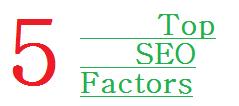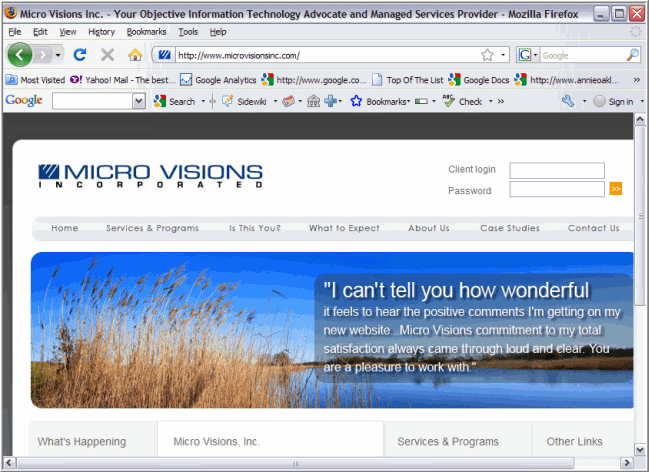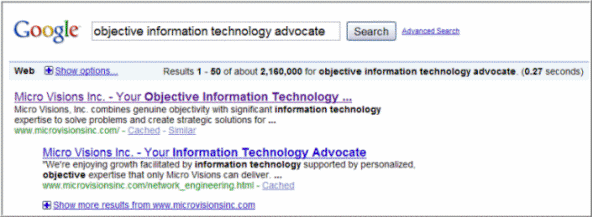Inbound links. Page hits. Pay per click. The sheer variety of SEO options can be overwhelming for businesses seeking to invest wisely and save costs.
Whether you’re new to SEO or a pro, your SEO strategy could likely use a tune-up. Fortunately, Top Of The List’s staff have their fingers on the pulse of what works—and what doesn’t.
President Beverly Mapes presents the SEOmoz nationwide survey of the top 5 search engine optimization factors:
- Factor #1: Keyword focused anchor text from external links
- Factor #2: External link popularity
- Factor #3: Diversity of link sources
- Factor #4: Keyword use in title tags
- Factor #5: Domain trustworthiness based on link distance
Factor #1: Keyword focused anchor text from inbound links
A full 73% of experts surveyed in the SEOmoz survey agreed that the #1 factor influencing search engine placement boils down to (drumroll please…)
Keyword focused anchor text from external links Keyword focused anchor text is what the words say that form the link(s) to your website. For example, if “Koeze” has another site linking to it, does the user click on:
a. Koeze
b. For the best cashews, click here, or
c. Try Koeze Gourmet Nuts, the best cashews around!
If you were in the gourmet nut business, example c would help your site the most in search engine placement for “best cashews.”
While almost all links to your site that come from external sources help your site, obtaining links that have keywords in the anchor text is one of the top factors that can influence your site’s search engine placement for those terms.
Factor #2: External link popularity
Based on 71% of SEO experts, the #2 factor that influences search engine optimization is:
External link popularity. If you thought we could move on to something else besides those incoming links to your site, it’s time to re-think the issue.
Not only is the anchor text of top importance in those links, but the quality and quantity of the inbound links to your site (called “link popularity”) is second in importance to the anchor text.
Quantity refers to “how many links” are coming into your site, so in general, the more the better.
If quality and quantity were separated in this popularity factor, we personally feel quality is the clear winner. We’ve seen websites with less than 200 quality inbound links placing at the top of the list on extremely competitive queries, and farther down the list are websites with over 1,000,000 non-quality inbound links.
While many factors are involved in placement, this is too large of a difference to ignore when it comes to quantity vs. quality. Some links simply do not carry as much “link juice” as other links do.
What makes a quality link? Search engine algorithms evaluate over 50 different factors about an incoming page link to determine quality, and thus how much “link juice” it will pass along to the website to which it links. Here are just a few of those factors:
- PageRank – In simple terms, PageRank is a “vote” from 0 to 10 which is assigned to every web page on the Internet. Pages linking to your site that have been assigned a higher PageRank, result in a higher quality link. This is sort of a snowball effect, since PageRank of any page is improved by all of the factors we are covering in this series of articles on SEO.
- Relevance – When the site linking to your site includes similar words and terms – meaning it is relevant that your two websites are linking – it increases the value of the link. For example, a tire dealer site that links to an automotive repair site would result in a more relevant link than if that tire dealer site linked to a day spa.
- The hierarchical page location of the inbound link on the external site – An easy way to measure this is in terms of “number of clicks” from the home page where the link resides. A link to your site from another site’s home page, or a page just one or two clicks away from the home page, is almost always more powerful than a link buried deeper into the site.
While almost all links to your site that come from external sources help your site, the popularity of the external website is the second of the top factors that can influence your site’s search engine placement on appropriate queries.
Factor #3: Diversity of link sources
Diversity of link sources means that the websites that link to your website should be from unique root domains. Like so many other areas of the search engine optimization field, there are numerous details that surround that short summary of what “diversity of link sources” and uniqueness of root domains really means.
Here are some primary details about link diversity:
- Link diversity involving the domain name itself – Sites linking to your site should be from a variety of domains. For instance, a site with 100 inbound links all from different websites is far more optimized than a site with 100 inbound links that come from a single blog. Diversify the sites that link to you!
- Diversity of the root domain type – This refers to the type of domain, such as .com, .net, .org, .edu, etc. For International sites, achieving links from other countries is important.
- The IP number – Every website is assigned an IP number, which is used in a technical way to ensure users arrive at the correct website when typing its domain name into an Internet browser. Companies that maintain the servers – called website hosts – receive a block of IP numbers, which they use to share among all the websites hosted by them. What this means to your link campaign is that websites linking to your site should be from sites that use a different website host than the one you use, else their IP number may be from the same “block” of IP numbers and not be as beneficial. For those of you who are tech savvy, here’s a free tool that will check the IP number of any website.
Almost all inbound links to your site are beneficial, so we do not recommend turning down link opportunities just because they are from non-diverse domains. However, keeping in mind this third top factor, diversity of links, can make those inbound links influence your site’s search engine placement even more.
Factor #4: Keyword use in title tags
The #4 search engine optimization factor is keyword use anywhere in the title tag. This factor is usually one of the easiest to optimize, since it involves simple changes directly on your website.
Where the Title Tag Displays on a Web page
While it may sound like the title tag goes at the top of your webpage, it actually goes at the top of your browser window. For example, here is a shot of Micro Visions’ home page.
The title tag is emphasized in the picture below, and reads “Micro Visions Inc. – Your Objective Information Technology Advocate and Managed Services Provider”:
Other Locations a Title Tag is Displayed
The title tag also appears as the underlined “link” when your website places on a SERP (search engine result page). Here’s an example of a Google SERP for the term “objective information technology advocate,” which is a keyword phrase in Micro Visions’ title tag:
As you can see, Micro Visions comes up first on this term, and the searched upon term is even in bold in the title tag.
Another thing to notice about the title tag displayed above is that part of it is truncated. Having longer title tags is your decision, but search engines will read up to 120 characters (including spaces) in that tag, so we tend to use as many as make sense for describing what is on that web page.
The Logic behind Title Tag Significance in Search Results
Most website visitors who are looking for something using a search engine will click on a link that contains the same keywords they searched on. Search engine developers view this user behavior as very significant, thus, if you put targeted keywords in the title tag on your pages, it helps your site’s placement on those keywords.
More Tips when Optimizing the Title Tag
As with SEO in general, there are numerous details about every strategy, and knowing and implementing as many as possible is what makes one site place higher than another and thus be more visible online. Here are a few more of those title tag details:
- Title tags should be unique per page. Time should be spent in identifying appropriate keywords, matching landing pages, and then optimizing the title tag for those keyword phrases.
- Use appropriate keywords that describe what is on that page as well as the search terms users are querying.
- Many CMS (content management system) website programs now have methods for you to add title tags yourself. If your CMS has this capability, you can do this yourself very easily.
- The source code for a title tag is very easy, and looks like this:
<title>Put title tag contents here</title>
On non-competitive keywords, title tag changes may result in placement without much more work, but on highly competitive keywords, the linking factors we discussed above are absolutely necessary. Combining appropriate links to optimized landing pages makes for powerful optimization.
Factor #5: Domain trustworthiness based on link distance
The final search engine optimization factor is Trustworthiness of the Domain Based on Link Distance from a Trusted Domain.
The concept of this factor is simple. If a site from a “Trusted Domain” links to your website, you are 1 link from a trusted domain (the closest distance you can be to a trusted domain without actually being the trusted domain). It is beneficial to be as close to a trusted domain as possible.
If a site from a “Trusted Domain” links to a website that then links to your website, you are 2 links from a trusted domain (still very close in distance). Search engines continue counting how many links your site is away from a trusted domain, and that affects your PageRank and search engine placement.
What is a trusted domain?
Determining what a trusted domain is represents the more complex portion of this factor. It is also one that is not completely known. While search engines give some information about how their algorithms work, this is one of the grey areas. The SEO community has some pieces to the puzzle, but not all of them.
Here are some of the things that the search community “in general” agrees are correct about a trusted domain:
- A trusted domain is determined by search engine algorithms, and seems to be “hand-picked” or “hard coded”
- A trusted domain designation applies to the entire domain, not a specific page on a site
- Trusted domains are generally older, high traffic sites that represent overwhelming authority or high expertise on a topic
- While a trusted domain will have a high page rank, not all sites with high page rank are trusted domains
Examples of Trusted Domains
Some examples of sites that are thought to be trusted domains include:
- Technorati, Stumbleupon, Digg
- Wikipedia, DMOZ
- Certain .gov and .edu domains
- News sites, BBC
- Big Brands
What Trusted Domains Are Not
Often the definition of a trusted domain can be confused with:
- A security certificate or “locked key” icon. This is NOT what the trusted domain factor refers to.
- A trusted relationship with another domain, which allows users on one website to share services of a different website. This is NOT what the trusted domain factor refers to either.
While SEO experts know a lot about search algorithms and how to achieve top placement, the trusted domain area is one that is more vague than others. Even so, trustworthiness of your domain based on link distance from a trusted domain is the 5th most important search engine optimization factor according to the community of SEO experts.
On Your Mark, Get Set…SEO!
By using these 5 factors to guide your SEO strategy, you’ll be well on your way to the top of search engine listings.
Better yet, let Top Of The List’s team of experts help you improve your website’s visibility with a custom SEO strategy. Top Of The List offers organic SEO packages which focus on all 5 top optimization factors, helping our clients achieve optimal search engine placement and drive increased target market traffic to their websites.
Contact Top Of The List today.
About the Author

Bev founded Top Of The List in 2006 and has over 25 years of experience working with technology. In her free time, she competes in dog agility competitions with her Golden Retrievers, Cosmo, and Finn.








